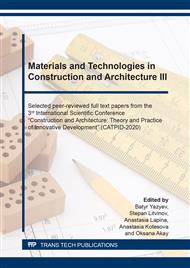p.109
p.116
p.123
p.130
p.136
p.144
p.151
p.158
p.164
Gypsum-Cement Composites Based on Volcanic Ash
Abstract:
The studies’ results to determine the gypsum, ash and Portland cement components proportions, which would ensure a decrease in the specific binder consumption, as well as the ash grain composition’s effect on the properties of the gypsum cement pozzolan composite, are presented. It was revealed that the use of volcanic ash together with Portland cement in gypsum concrete composites allows reducing gypsum consumption by up to 50% without a significant decrease in strength characteristics. At the same time, the developed gypsum concrete composites have increased water resistance. The influence of the ash particle size distribution on the strength properties of the composite is ambiguous; in the compositions with a high ash content it is advisable to use larger fractions, and with a content of less than 50% ash in the composite, - the small fractions. To study the parameters’ effect of the dispersed reinforcement with basalt fibers on the properties of a gypsum-cement composite, an experiment with such a second-order composite rotatable plan as regular hexagon was conducted. It was found that the maximum values of optimization parameters are observed in the central area of the plan with and . The compressive strength of a fiber gypsum cement pozzolan composite increases by 1.15-1.18 times, when bending, by 1.56-1.72 times with respect to the strength of the initial matrix.
Info:
Periodical:
Pages:
136-143
Citation:
Online since:
September 2020
Authors:
Price:
Сopyright:
© 2020 Trans Tech Publications Ltd. All Rights Reserved
Share:
Citation:


